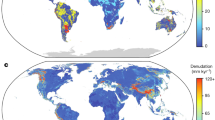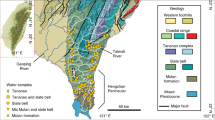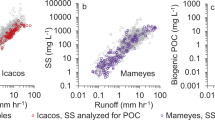Abstract
Soils of the northern high latitudes store carbon over millennial timescales (thousands of years) and contain approximately double the carbon stock of the atmosphere1,2,3. Warming and associated permafrost thaw can expose soil organic carbon and result in mineralization and carbon dioxide (CO2) release4,5,6. However, some of this soil organic carbon may be eroded and transferred to rivers7,8,9. If it escapes degradation during river transport and is buried in marine sediments, then it can contribute to a longer-term (more than ten thousand years), geological CO2 sink8,9,10. Despite this recognition, the erosional flux and fate of particulate organic carbon (POC) in large rivers at high latitudes remains poorly constrained. Here, we quantify the source of POC in the Mackenzie River, the main sediment supplier to the Arctic Ocean11,12, and assess its flux and fate. We combine measurements of radiocarbon, stable carbon isotopes and element ratios to correct for rock-derived POC10,13,14. Our samples reveal that the eroded biospheric POC has resided in the basin for millennia, with a mean radiocarbon age of 5,800 ± 800 years, much older than the POC in large tropical rivers13,14. From the measured biospheric POC content and variability in annual sediment yield15, we calculate a biospheric POC flux of  teragrams of carbon per year from the Mackenzie River, which is three times the CO2 drawdown by silicate weathering in this basin16. Offshore, we find evidence for efficient terrestrial organic carbon burial over the Holocene period, suggesting that erosion of organic carbon-rich, high-latitude soils may result in an important geological CO2 sink.
teragrams of carbon per year from the Mackenzie River, which is three times the CO2 drawdown by silicate weathering in this basin16. Offshore, we find evidence for efficient terrestrial organic carbon burial over the Holocene period, suggesting that erosion of organic carbon-rich, high-latitude soils may result in an important geological CO2 sink.
This is a preview of subscription content, access via your institution
Access options
Subscribe to this journal
Receive 51 print issues and online access
$199.00 per year
only $3.90 per issue
Buy this article
- Purchase on Springer Link
- Instant access to full article PDF
Prices may be subject to local taxes which are calculated during checkout



Similar content being viewed by others
References
Gorham, E. Northern peatlands: Role in the carbon cycle and probable responses to climatic warming. Ecol. Appl. 1, 182–195 (1991)
Hugelius, G. et al. Estimated stocks of circumpolar permafrost carbon with quantified uncertainty ranges and identified data gaps. Biogeosciences 11, 6573–6593 (2014)
Schuur, E. A. G. et al. Vulnerability of permafrost carbon to climate change: Implications for the global carbon cycle. Bioscience 58, 701–714 (2008)
Guo, L., Ping, C.-L. & Macdonald, R. W. Mobilization pathways of organic carbon from permafrost to arctic rivers in a changing climate. Geophys. Res. Lett. 34, L13603 (2007)
MacDougall, A. H., Avis, C. A. & Weaver, A. L. Significant contribution to climate warming from the permafrost carbon feedback. Nature Geosci. 5, 719–721 (2012)
Schädel, C. et al. Circumpolar assessment of permafrost C quality and its vulnerability over time using long-term incubation data. Glob. Change Biol. 20, 641–652 (2014)
Goñi, M. A., Yunker, M. B., Macdonald, R. W. & Eglinton, T. I. The supply and preservation of ancient and modern components of organic carbon in the Canadian Beaufort Shelf of the Arctic Ocean. Mar. Chem. 93, 53–73 (2005)
Vonk, J. E. et al. Activation of old carbon by erosion of coastal and subsea permafrost in Arctic Siberia. Nature 489, 137–140 (2012)
Vonk, J. E. & Gustafsson, O. Permafrost-carbon complexities. Nature Geosci. 6, 675–676 (2013)
Galy, V. et al. Efficient organic carbon burial in the Bengal fan sustained by the Himalayan erosional system. Nature 450, 407–410 (2007)
Stein, R. & Macdonald, R. W. The Organic Carbon Cycle in the Arctic Ocean (Springer, 2004)
Macdonald, R. W. et al. A sediment and organic carbon budget for the Canadian Beaufort Shelf. Mar. Geol. 144, 255–273 (1998)
Galy, V. & Eglinton, T. I. Protracted storage of biospheric carbon in the Ganges-Brahmaputra basin. Nature Geosci. 4, 843–847 (2011)
Bouchez, J. et al. Source, transport and fluxes of Amazon River particulate organic carbon: insights from river sediment depth-profiles. Geochim. Cosmochim. Acta 133, 280–298 (2014)
Carson, M. A., Jasper, J. N. & Conly, F. M. Magnitude and sources of sediment input to the Mackenzie Delta, Northwest Territories, 1974–94. Arctic 51, 116–124 (1998)
Gaillardet, J., Dupré, B., Louvat, P. & Allegre, C. A. Global silicate weathering and CO2 consumption rates deduced from the chemistry of large rivers. Chem. Geol. 159, 3–30 (1999)
Sundquist, E. T. & Visser, K. in Treatise on Geochemistry (ed. Schlesinger, W. H. ), Vol. 8 Biogeochemistry 425–472 (Elsevier-Pergamon, 2004)
Blair, N. E. & Aller, R. C. The fate of terrestrial organic carbon in the marine environment. Annu. Rev. Mar. Sci. 4, 17.1–17.23 (2012)
Hayes, J. M., Strauss, H. & Kaufman, A. J. The abundance of 13C in marine organic matter and isotopic fractionation in the global biogeochemical cycle of carbon during the past 800 Ma. Chem. Geol. 161, 103–125 (1999)
Berner, R. A. Atmospheric CO2 levels over Phanerozoic time. Science 249, 1382–1386 (1990)
Hilton, R. G., Gaillardet, J., Calmels, D. & Birck, J. L. Geological respiration of a mountain belt revealed by the trace element rhenium. Earth Planet. Sci. Lett. 403, 27–36 (2014)
Hilton, R. G. et al. Climatic and geomorphic controls on the erosion of terrestrial biomass from subtropical mountain forest. Glob. Biogeochem. Cycles 26, http://dx.doi.org/10.1029/2012GB004314 (2012)
Galy, V., Peucker-Ehrenbrink, B. & Eglinton, T. Global carbon export from the terrestrial biosphere controlled by erosion. Nature 521, 204–207 (2015)
Burdige, D. J. Burial of terrestrial organic matter in marine sediments: a re-assessment. Glob. Biogeochem. Cycles 19, GB4011 (2005)
MacDonald, G. M. et al. Rapid development of the circumarctic peatland complex and atmospheric CH4 and CO2 variations. Science 314, 285–288 (2006)
Dellinger, M. et al. Lithium isotopes in large rivers reveal the cannibalistic nature of modern continental weathering and erosion. Earth Planet. Sci. Lett. 401, 359–372 (2014)
Kuhry, P. & Vitt, D. H. Fossil carbon/nitrogen ratios as a measure of peat decomposition. Ecology 77, 271–275 (1996)
Feng, X. et al. Differential mobilization of terrestrial carbon pools in Eurasian Arctic river basins. Proc. Natl Acad. Sci. USA 110, 14168–14173 (2013)
Goñi, M. A. et al. Distribution and sources of organic matter in surface marine sediments across the North American Arctic margin. J. Geophys. Res. 118, 4017–4035 (2013)
Drenzek, N. J., Montluçon, D. B., Yunker, M. B., Macdonald, R. W. & Eglinton, T. I. Constraints on the origin of sedimentary organic carbon in the Beaufort Sea from coupled molecular 13C and 14C measurements. Mar. Chem. 103, 146–162 (2007)
Schuur, E. A. G. et al. Climate change and the permafrost carbon feedback. Nature 520, 171–179 (2015)
Hilton, R. G., Galy, A., Hovius, N., Horng, M. J. & Chen, H. The isotopic composition of particulate organic carbon in mountain rivers of Taiwan. Geochim. Cosmochim. Acta 74, 3164–3181 (2010)
Moran, K., Hill, P. R. & Blasco, S. M. Interpretation of piezocone penetrometer profiles in sediment from the Mackenzie Trough, Canadian Beaufort Sea. J. Sedim. Petrol. 59, 88–97 (1989)
Komada, T., Anderson, M. R. & Dorfmeier, C. L. Carbonate removal from coastal sediments for the determination of organic carbon and its isotopic signatures, 13C and 14C: comparison of fumigation and direct acidification by hydrochloric acid. Limnol. Oceanogr. 6, 254–262 (2008)
Whiteside, J. H. et al. Pangean great lake paleoecology on the cusp of the end-Triassic extinction. Palaeogeogr. Palaeoclimatol. Palaeoecol. 301, 1–17 (2011)
Stuiver, M. & Polach, H. A. Discussion: Reporting of 14C data. Radiocarbon 19, 55–63 (1977)
Stuiver, M. & Reimer, P. J. Extended 14C database and revised CALIB radiocarbon calibration program. Radiocarbon 35, 215–230 (1993)
Reimer, P. J. et al. IntCal09 and Marine09 radiocarbon age calibration curves, 0–50,000 years cal BP. Radiocarbon 51, 1111–1150 (2009)
Coulthard, R. D., Furze, M. F. A., Pienkowski, A. J., Nixon, F. C. & England, J. H. New marine ΔR values for Arctic Canada. Quat. Geochronol. 5, 419–434 (2010)
Johnston, D. T., Macdonald, F. A., Gill, B. C., Hoffman, P. F. & Schrag, D. P. Uncovering the Neoproterozoic carbon cycle. Nature 483, 320–323 (2012)
Bird, M., Santruckova, H., Lloyd, J. & Lawson, E. The isotopic composition of soil organic carbon on a north-south transect in western Canada. Eur. J. Soil Sci. 53, 393–403 (2002)
Brown, J. et al. Circum-Arctic Map of Permafrost and Ground Ice Conditions http://nsidc.org/data/ggd318 (National Snow and Ice Data Center/World Data Center for Glaciology, 1998)
Acknowledgements
Radiocarbon measurements were funded by the Natural Environment Research Council (NERC), UK (Allocation 1611.0312) to R.G.H and C.B. Fieldwork was funded by CNRS (OXYMORE and CANNIBALT) to J.G. and R.G.H., the Woods Hole Oceanographic Institution Arctic Research Initiative to V.G. and an Early Career Research Grant by the British Society for Geomorphology to R.G.H. V.G. was supported by the US National Science Foundation (OCE-0928582) and H.C. by a Royal Society University Fellowship. The research was carried out under Scientific Research Licence No. 14802 issued by the Aurora Research Centre, who we thank for logistical support (in particular D. Ross and J. Gareis). We also thank I. Peters for preparation of offshore borehole samples, C. Johnson, X. Philippon and M. Bollard for analytical assistance, E. Tipper and K. Hilton for field assistance and discussions and D. Ofukany, G. Lennie, R. Wedel and R. Pilling of Environment Canada for loan of equipment.
Author information
Authors and Affiliations
Contributions
R.G.H., V.G. and J.G. conceived the study and R.G.H., J.B., D.C., V.G. and M.D. designed the fieldwork and collected the river samples. M.O. and H.C. collected sediment and carbonate data from the offshore borehole. R.G.H., V.G., M.D., C.B. and D.G. processed the samples and carried out the geochemical analyses. R.G.H. wrote the manuscript with input from all co-authors.
Corresponding author
Ethics declarations
Competing interests
The authors declare no competing financial interests.
Extended data figures and tables
Extended Data Figure 1 The location of river depth profiles collected from the Mackenzie River.
Three locations along the Mackenzie River were sampled (circles) at the delta (black), Tsiigehtchic (grey) and Norman Wells (white) in addition to the major tributaries, the Liard River (red diamond), Arctic Red River (light blue square) and Peel River (dark blue square). The location of the sediment core MTW01 from the Mackenzie trough is shown (triangle). a, Major river channels (black lines) overlain on digital elevation model GMTED 15 arcsec with upstream sediment source catchment areas delineated by flow accumulation and flow direction outputs from the digital elevation model (dotted lines). The Great Slave Lake is indicated upstream of the Liard confluence and acts as an effective sediment trap in the basin15. b, Permafrost zone coverage in the upstream areas of the basin42. White rectangle shows the sample locations near the Mackenzie delta displayed in c, overlain on LANDSAT imagery.
Extended Data Figure 2 Source of particulate organic carbon in the Mackenzie River basin.
a, Radiocarbon content (reported as Fmod) as a function of the stable isotope ratio of organic carbon (δ13Corg) of river sediments for the Mackenzie River (circles) and its major tributaries (diamonds and squares) for suspended load samples from river depth profiles (filled symbols) and river bed materials (open symbols). Dashed lines and shaded regions show hypothetical compositions produced by mixing rock-derived POCpetro40 and POCbiosphere41. b, Fmod as a function of Al/OCtotal. High Al/OCtotal and low Fmod correspond to the petrogenic source of POC (POCpetro). Linear trends are shown for the Peel and Arctic Red rivers (blue, y = (−1.5 ± 0.3 × 10−6)x + (0.85 ± 0.11), r2 = 0.85, P < 0.02), the Mackenzie River at delta (black, y = (−5.9 ± 0.5 × 10−6)x + (0.65 ± 0.03), r2 = 0.95, P < 0.001), and the Mackenzie and Liard rivers (grey, y = (−2.3 ± 0.3 × 10−6)x + (0.56 ± 0.03), r2 = 0.82, P < 0.001). The intercepts at Fmod = 0 for POCpetro are given with uncertainty (±1 s.d.) and are different for each sub-basin, reflecting the distribution of organic carbon-rich rocks in the Mackenzie mountains40. c, Measured δ13Corg versus those predicted by the endmember mixing model (EMM-predicted) (equations (1) and (2); Methods). The good agreement between measured and predicted values within the uncertainty on the measurements suggests that mixing of POCpetro and POCbiosphere can explain the first-order variability in δ13Corg values between catchments and between suspended load and river bed materials.
Extended Data Figure 3 Radiocarbon age of biospheric particulate organic carbon in the Mackenzie River derived from the mixing analysis.
The number of POCbiosphere measurements of a given range of 14C ages is shown for each sampling location as a narrow rectangle. The distribution of published basal peat sample 14C ages for the Mackenzie River basin25 is shown as wide rectangles.
Extended Data Figure 4 River particulate organic carbon in the Mackenzie basin.
Organic carbon concentration as a function of Al/Si, which is a function of grain size in the Mackenzie River basin26. Analytical errors (2 s.d.) are shown as grey lines if larger than the point size.
Extended Data Figure 5 Stable isotope composition and nitrogen to organic carbon ratio of terrestrial and marine sediments.
Suspended sediments from the Mackenzie River (circles) at the delta (black), Tsiigehtchic (grey) and Norman Wells (white) are shown. Marine sediment samples from the MTW01 sediment core (this study, triangles, black <63 µm, grey >63 µm) are shown with published surface sediment samples from the Beaufort Sea (white triangles) and Davis Strait (black squares)7,29. The terrestrial POC field shows an indicative range of values measured in the Mackenzie River. The marine OC field shows values expected for Arctic Ocean marine OC. Analytical errors (2 s.d.) are shown as grey lines if larger than the point size.
Rights and permissions
About this article
Cite this article
Hilton, R., Galy, V., Gaillardet, J. et al. Erosion of organic carbon in the Arctic as a geological carbon dioxide sink. Nature 524, 84–87 (2015). https://doi.org/10.1038/nature14653
Received:
Accepted:
Published:
Issue Date:
DOI: https://doi.org/10.1038/nature14653
This article is cited by
-
Millennial-aged pyrogenic carbon in high-latitude mineral soils
Communications Earth & Environment (2024)
-
Future directions for river carbon biogeochemistry observations
Nature Water (2024)
-
Extreme rainstorms drive exceptional organic carbon export from forested humid-tropical rivers in Puerto Rico
Nature Communications (2022)
-
Ice-dominated Arctic deltas
Nature Reviews Earth & Environment (2022)
-
Carbon and sediment fluxes inhibited in the submarine Congo Canyon by landslide-damming
Nature Geoscience (2022)
Comments
By submitting a comment you agree to abide by our Terms and Community Guidelines. If you find something abusive or that does not comply with our terms or guidelines please flag it as inappropriate.



